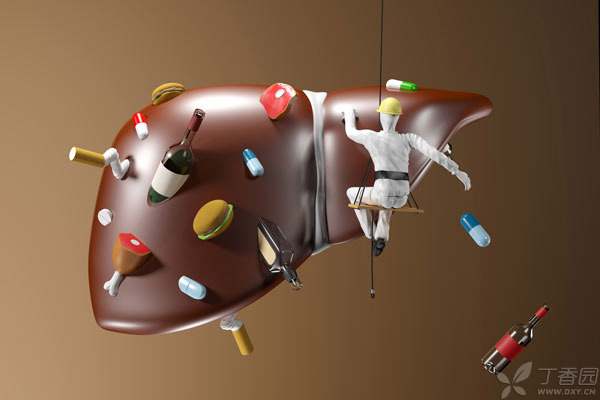
Life is better, pressure is greater, social parties are more, drinking is more, but problems also come. Thanks to all kinds of radio advertisements, all kinds of liver-nourishing tea, liver-clearing spirit and liver-softening treasure are also popular, and they often boast that [one bag comes before drinking, and another bag comes after drinking]. Therefore, it is very necessary to scientifically and objectively talk about [alcoholic hepatitis] with everyone.
After drinking, what happened?
Like other foods, After a glass of wine, Into the stomach, Then it passes through the duodenum to the small intestine. In the gastrointestinal tract, alcohol is absorbed by mucosa, enters the venous system and then flows to the liver, the chemical plant of the human body. In the liver, it is converted into acetaldehyde by the action of enzyme A (scientific name alcohol dehydrogenase), and then acetic acid is generated by enzyme B (scientific name acetaldehyde decarboxylase), which is finally decomposed into carbon dioxide and water and discharged out of the body.
For people with less A enzyme, the first step of ethanol metabolism cannot be successfully completed, resulting in ethanol accumulation acting on the central nervous system, which is manifested as one cup pouring and poor capacity for liquor.
For people with less B enzyme, ethanol can be metabolized into acetaldehyde, but it cannot be further converted into acetic acid and accumulated in the body as soon as possible. Acetaldehyde will cause vasodilation of skin and mucosa as [blushing and thick neck].
Therefore, whether you can drink or not depends on two enzymes, which in turn depend on congenital genetic constitution, age, body condition, etc. Individual differences are large, and the safe amount of alcohol cannot be measured by a unified standard.
Is what alcoholic?
Alcoholic liver disease refers to alcoholic liver disease, which is a chronic liver disease caused by long-term heavy drinking. The initial manifestation is alcoholic fatty liver disease, which can further develop into alcoholic hepatitis, alcoholic liver fibrosis and alcoholic cirrhosis.
We usually refer to alcoholic fatty liver, which is caused by alcohol to fatty degeneration of liver cells. Alcoholic fatty liver is often asymptomatic or mild, and may have fatigue, loss of appetite, dull pain or discomfort in the right upper abdomen, and liver swelling to varying degrees.
The clinical manifestations of alcoholic hepatitis vary greatly. It often occurs in the near future, after several weeks to several months of heavy drinking, with symptoms such as general malaise, loss of appetite, nausea, vomiting, fatigue, liver pain, etc.
Alcoholic cirrhosis may be accompanied by chronic alcoholism such as psychiatric neurological symptoms, chronic pancreatitis, etc.

Which groups are prone to alcoholic hepatitis?
European and American guidelines mention that people who consume 80 g of alcohol a day for more than 10 years are prone to alcoholic hepatitis. This figure is only an average, and individual differences are relatively large, so it cannot be generalized.
In short, long-term alcoholics are at high risk.
For individual alcoholic hepatitis patients, Often there are no symptoms, Or have right upper abdominal distension pain, loss of appetite, fatigue, weight loss, etc., However, there is no specific manifestation. B-ultrasound examination can find diffuse enhancement of liver echo, or CT examination can find a decrease in liver density to further confirm the diagnosis. CT examination of normal people shows that liver density is higher than spleen, and some alcoholics have liver density lower than spleen, which is the result of fat infiltration.
Now some hospitals have carried out B-ultrasound instantaneous elasticity measurement, which can tell you the degree of fatty liver with a quantitative index.
What are the hazards of excessive drinking? How is moderate drinking?
It seems that there is no Chinese poet who does not like drinking, such as Tao Yuanming. Li Bai, a fellow poet, once left a poem for him: “Su Qin has no strings, and Lu Jiu uses Ge Jin.”
There are many similar stories. It can be seen that drinking is addictive and it is not easy to control it.
However, excessive drinking has many health risks, including:
- Cardiovascular problems: Increased hypertension, high triglycerides and myocardial diseases. Increased cancer risk: It is closely related to the onset of esophageal cancer, rectal cancer, breast cancer and other cancers. Other health problems: May cause obesity and liver damage.
So, how is the right amount? How do you compare the amount of different wines?
According to < < Dietary Guidelines for Chinese Residents 2007 Edition > >, considering the harmful effects of excessive drinking on health and the possible health benefits of moderate drinking, as well as the limited drinking values for adults in other countries, the Chinese Nutrition Society has given the following suggestions on the limited drinking values for adults.
Adult males drink no more than 25 g of alcohol a day, equivalent to:
- 750 mL beer; Or 250 mL of wine; Or 75 g of 38-degree liquor; Or 50 g of high-grade liquor.
Adult women drink no more than 15 g of alcohol a day, which is equivalent to:
- 450 mL beer; Or wine 150 ml; Or 38-degree liquor 50 g.
So far, the protective effect and mechanism of moderate drinking on cardiovascular system have yet to be confirmed by in-depth research. Moderate physical activity, maintaining a healthy weight and quitting smoking have been proved to be effective in preventing cardiovascular diseases. Therefore, the guidelines do not recommend anyone to start drinking or drink frequently for the sake of preventing heart disease.
For health reasons, Dr. Clove advised everyone to give up drinking.
I drank a lot of wine before. What should I do to prevent alcoholic hepatitis?
1. Abstinence, of course!
Mild or moderate alcoholic hepatitis can be improved. Liver fat deposition usually subsides within weeks or months of abstinence, and generally does not require additional hypolipidemic drugs, and even can completely return to normal. Even for those patients whose alcohol has caused fibrosis and liver cirrhosis, it is of great benefit and the long-term survival rate is significantly improved.
2. Proper exercise, regular work and rest, balanced diet
In fact, many organs of our human body do not need external drugs to protect, protect and nourish what. They have a very good compensation and repair mechanism. As long as they can provide a [harmonious] environment, they will show their best state. On the contrary, drugs with unknown components will increase the burden on organs and even play a role in interference and destruction.
Therefore, don’t listen to the advertisement at all [bag Qinggan tea before meals and then after meals]!
3. Attention should be paid to it.
Alcoholic hepatitis is not a soft persimmon, In Europe and America, Alcoholism has been the most common cause of fatty liver and cirrhosis, Therefore, secondary liver cancer also has a large number of people. In our country in recent years also has an upward trend, and hepatitis B or hepatitis C infection long-term heavy drinking will increase the risk of alcoholic liver cirrhosis. Therefore, if alcoholic liver disease has been more serious, or should be timely to the regular liver disease department for diagnosis and treatment.
Responsible Editor: Ji Lingyan
